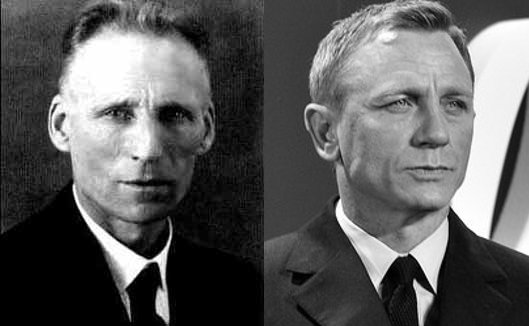Cakes, Custard, Categories and Colbert
Posted by John Baez
As you probably know, Eugenia Cheng has written a book called Cakes, Custard and Category Theory: Easy Recipes for Understanding Complex Maths, which has gotten a lot of publicity. In the US it appeared under the title How to Bake Pi: An Edible Exploration of the Mathematics of Mathematics, presumably because Americans are less familiar with category theory and custard (not to mention the peculiar British concept of “pudding”).
Tomorrow, Wednesday November 4th, Eugenia will appear on The Late Show with Stephen Colbert. There will also be another lesser-known guest who looks like this:

Apparently his name is Daniel Craig and he works on logic—he proved something called the Craig interpolation theorem. I hear he and Eugenia will have a duel from thirty paces to settle the question of the correct foundations of mathematics.
Anyway, it should be fun! If you think I’m making this all up, go here. She’s really going to be on that show.
I’m looking forward to this because while Eugenia learned category theory as a grad student at Cambridge, mainly from her advisor Martin Hyland and Peter Johnstone, Hyland became interested in n-categories and Eugenia wound up doing her thesis on the opetopic approach to n-categories which James Dolan and I had dreamt up. I visited Cambridge for the first time around then, and we wound up becoming friends. It’s nice to see she’s bringing math and even category theory to a large audience.
Here’s my review of Eugenia’s book for the London Mathematical Society Newsletter:
Eugenia Cheng has written a delightfully clear and down-to-earth explanation of the spirit of mathematics, and in particular category theory, based on their similarities to cooking. Sometimes people complain about a math textbook that it’s “just a cookbook”, offering recipes but no insight. Cheng shows the flip side of this analogy, providing plenty of insight into mathematics by exploring its resemblance to the culinary arts. Her book has recipes, but it’s no mere cookbook.
Among all forms of cooking, it seems Cheng’s favorite is the baking of desserts—and among all forms of mathematics, category theory. This is no coincidence: like category theory, the art of the pastry chef is one of the most exacting, but also one of the most delightful, thanks to the elegance of its results. Cheng gives an example: “Making puff pastry is a long and precise process, involving repeated steps of chilling, rolling and foldking to create the deliciously delicate and buttery layers that makes puff pastry different from other kinds of pastry.”
However, she does not scorn the humbler branches of mathematics and cooking, and there’s nothing effete or snobby about this book. No special background is needed to follow it, so if you’re a mathematician who wants your relatives and friends to understand what you are doing and why you love it, this is the perfect gift to inflict on them.
On the other hand, experts may be disappointed unless they pay close attention. There is a fashionable sort of book that lauds the achievements of mathematical geniuses, explaining them in just enough detail to give the reader a sense of awe: typical titles are A Beautiful Mind and The Man Who Knew Infinity. Cheng avoids this sort of hagiography, which may intimidate as often as it inspires. Instead, her book uses examples to show that mathematics is close to everyday experience, not to be feared.
While the book is written in bite-sized pieces suitable for the hasty pace of modern life, it has a coherent architecture and tells an overall story. It does this so winningly and divertingly that one might not even notice. The book’s first part tackles the question “what is mathematics?” The second asks “what is category theory?” Unlike timid people who raise big questions, play with them a while, and move on, Cheng actually proposes answers! I will not attempt to explain them, but the short version is that mathematics exists to make difficult things easy, and category theory exists to make difficult mathematics easy. Thus, what mathematics does for the rest of life, category theory does for mathematics.
Of course, mathematics only succeeds in making a tiny part of life easy, and Cheng admits this freely, saying quite a bit about the limitations of mathematics, and rationality in general. Similarly, category theory only succeeds in making small portions of mathematics easy—but those portions lie close to the glowing core of the subject, the part that illuminates the rest.
And as Cheng explains, illumination is what we most need today. Mere information, once hard to come by, is now cheap as water, pouring through the pipes of the internet in an unrelenting torrent. Your cell phone is probably better at taking square roots or listing finite simple groups than you will ever be. But there is much more to mathematics than that—just as cooking is much more than merely following a cookbook.


Re: Cakes, Custard, Categories and Colbert
Well, that’s pretty strong incentive to catch the show tomorrow! I was a big fan of the Colbert Report while it lasted, and caught just a bit of the new Late Night during its first week (during all the hoopla), but haven’t tuned in recently for fear of being disappointed…
Could it be that Stephen Colbert is a fan of mathematics? He’s also interviewed Terence Tao and Edward Frenkel.
Possible nitpick: does Eugenia spell it ‘pastry’, or ‘pastery’? I see two places where pastry is puffed up with an extra ‘e’, so was just wondering.